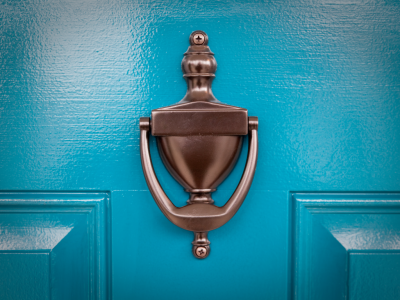
Paint Your Front Door Like a Pro!
Ready for an excellent impact-boosting project for your home? How about painting your front door? Getting the best results requires more than selecting the right color and choosing the best type of paint, although those are vital first steps.
With those decisions made, you’re ready to select the right time to paint your door, gather helpful tools, and use the best painting techniques.
Step 1. Pick the Right Time
Paint needs time and optimal weather conditions to cure and form a solid, even film, so plan your project based on the weather forecast. Allow a few days to complete all the prep and paint steps, including drying times.
Schedule this project when daytime temps are at least 50 degrees (Fahrenheit), and humidity levels are low. Ideally, temperatures should not fall below freezing for several days and nights after painting day.
Too-cool or too-damp conditions will leave your door tacky and prevent complete curing, which can cause long-term issues. Conversely, if it’s too hot outside, your paint will dry too quickly, which could prevent a smooth surface or create permanent brush marks.
Moderate temperatures help the paint to “settle in” smoothly for a polished, professional appearance.
Step 2. Gather Your Materials
In addition to purchasing the best paint for your project, pull together these supplies before removing the door:
- Screwdrivers
- Two sawhorses
- Painter’s tape
- 2” high-quality paintbrush
- Mini paint roller and pan
- Tack cloth
- Sanding sponge, sandpaper, or steel wool
- Wire brush
- Paint scraper
- Filler
- Drop cloth
- Degreasing cleaner
- Cleaning cloth
- Diluted bleach (if you need to remove mold)
- Gloves and goggles (or safety glasses)
Step 3: Remove the Door
You’ll get the best results if you detach the door from the frame and remove all the hardware. Prepare your work area by spreading out your drop cloth and placing the sawhorses on it.
While the door is still on its hinges, remove the hardware and place any knobs, latches, screws, etc., in a container to avoid losing any pieces.
Once these items are detached, remove the hinge pins and move the door so it’s resting stably on the sawhorses at an easy-to-reach height. Remove the hinge plates, adding them to your hardware container.
Step 4: Prepare the Surface
Clean – Use a degreasing cleaner to remove all dirt, grease, and grime. If your door has any mold, use a diluted bleach water solution to kill and remove it. Be sure to use gloves and goggles and work in a well-ventilated area. Rinse thoroughly. Let the door dry completely before moving to the next step.
Scrub – Clear off any loose, flaking, or chipped paint with a wire brush, sandpaper, or sanding sponge. You want to rough up the surface and remove any chalky oxidation from the old paint. If your wooden door has any rotted areas, dig those out until you hit solid wood. On metal doors, sand down any rust patches.
Patch – if your door has cracks, gouges, or dings, fill them with a compound formulated for wood, metal, or fiberglass. If a damaged section is large or deep, you may have to patch the area twice if a crack forms in the center as it dries. Be sure to let the filler dry completely before taking the next step. (This may take several days.)
Sand - Sand all the surfaces smooth. Use a tack cloth or a slightly damp rag to remove all dust remnants.
Mask – If your door has glass panels, be sure to mask them with painter’s tape before priming or painting.
Prime – If you are using a priming product before you paint, prime the door’s entire surface. Ideally, your primer should match the color you selected for your door.
Note: If you prefer painting your door without removing it, be sure to detach any removable hardware and tape off anything that cannot be removed, like the hinges. Follow the same surface preparation instructions above.
Step 5: Paint
Using your 2-inch brush, paint any recessed or textured trim areas first. Once the brushwork is finished, switch to your mini roller to tackle the flat portions of the door.
Thin coats are better than thick ones. You should be able to get a fantastic finish in 2-3 coats. Be sure to let the paint dry completely between coats.
Once you’ve applied a final coat, it’s time to remove any painter’s tape. Don’t wait until the paint is completely dry. For the best results, pull off the tape at a 45-degree angle.
When painting a hanging door, leave the door open until it dries and cures completely—which may take several days. Also, note that you run a higher risk of paint runs when painting a hanging door. Watch for those and brush them away immediately.
Step 6: Replace Hardware
Now it’s time to reinstall your old door hardware—or swap it out with a new set that complements the fresh color of your front door and provides an even more significant visual boost.
This DIY project can make a huge difference in your home’s “personality” and will instantly enhance curb appeal.
